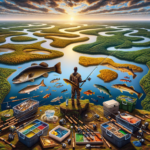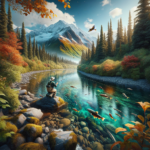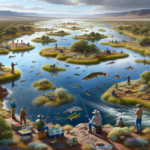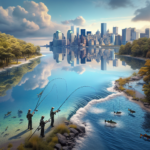Fishing in Missouri: Lakes, Rivers, and Reservoirs

Introduction
Did you know that Missouri is home to over 200 species of fish, making it a prime destination for anglers of all skill levels? Whether you’re a seasoned pro or a weekend warrior, Missouri’s diverse aquatic ecosystems offer something for everyone. This article will guide you through the best fishing spots in Missouri, including lakes, rivers, and reservoirs, and provide you with essential tips, techniques, and gear recommendations to make your fishing trip a success.
Fishing in Missouri is not just a pastime; it’s a way of life. From the serene waters of the Ozarks to the bustling banks of the Missouri River, the state offers a variety of fishing experiences that cater to different preferences and skill levels. This article will cover everything you need to know about fishing in Missouri, including the best techniques, species information, top fishing spots, seasonal considerations, and more.
Understanding the ins and outs of fishing in Missouri is crucial for anyone looking to make the most of their time on the water. Whether you’re aiming to catch a trophy bass or simply enjoy a peaceful day by the lake, this guide will provide you with the knowledge and tools you need to succeed.
Background/Context
Historical or Cultural Significance
Fishing has been an integral part of Missouri’s culture and history for centuries. Native American tribes, such as the Osage and Missouri, relied on the state’s rivers and lakes for sustenance. European settlers continued this tradition, and today, fishing remains a popular recreational activity. Missouri’s rich fishing heritage is celebrated through various festivals and events, making it a significant aspect of the state’s cultural identity.
Geographical Overview
Missouri is geographically diverse, featuring rolling hills, expansive plains, and numerous water bodies. The state’s climate varies from humid continental in the north to humid subtropical in the south, providing a range of fishing conditions throughout the year. Major water bodies include the Missouri River, Lake of the Ozarks, Table Rock Lake, and Truman Reservoir, each offering unique fishing opportunities.
Key Points/Details
Fishing Techniques
Technique Overview
Missouri offers a variety of fishing techniques, including fly fishing, baitcasting, and trolling. Fly fishing is popular in the state’s clear, cold-water streams, while baitcasting and trolling are commonly used in larger lakes and reservoirs.
When and Where to Use
Fly fishing is best suited for streams and rivers like the Current River and Meramec River, especially during spring and fall when water levels are optimal. Baitcasting and trolling are effective in larger bodies of water like Lake of the Ozarks and Truman Reservoir, particularly during the summer months.
Recommended Gear
- Fly Fishing: 5-6 weight rods, floating lines, and a variety of dry and wet flies.
- Baitcasting: Medium-heavy rods, baitcasting reels, and lures such as crankbaits and spinnerbaits.
- Trolling: Heavy rods, trolling reels, and deep-diving lures or live bait.
Species Information
Species Overview
Missouri’s waters are home to a variety of fish species, including largemouth bass, smallmouth bass, crappie, catfish, and trout. Each species has its own habits and preferred habitats, making them unique challenges for anglers.
Best Practices
For largemouth bass, focus on shallow waters with plenty of cover, such as weed beds and submerged logs. Smallmouth bass prefer rocky areas with clear water. Crappie are often found near submerged structures, while catfish are bottom-dwellers that thrive in deeper waters. Trout are typically found in cold-water streams and rivers.
Location Information
Top Fishing Spots
- Lake of the Ozarks: Known for its largemouth bass and crappie fishing, with numerous access points and amenities.
- Table Rock Lake: Offers excellent smallmouth bass fishing and is a popular spot for tournaments.
- Truman Reservoir: A prime location for catfish and crappie, with ample camping and boating facilities.
- Current River: Ideal for trout fishing, with clear waters and scenic surroundings.
Regulations and Licenses
Missouri requires anglers to have a valid fishing license, which can be purchased online or at local retailers. Specific regulations, such as catch limits and seasonal restrictions, vary by location and species. It’s essential to check the Missouri Department of Conservation’s website for up-to-date information.
Seasonal Considerations
Seasonal Variations
Fishing conditions in Missouri change throughout the year. Spring and fall are generally the best times for fishing, with moderate temperatures and active fish. Summer can be productive but may require early morning or late evening trips to avoid the heat. Winter fishing is possible, especially for species like trout, but requires additional preparation and gear.
Best Times to Fish
The optimal times for fishing in Missouri are early morning and late evening, regardless of the season. These times offer cooler temperatures and increased fish activity. Specific seasons, such as spring for bass and fall for trout, can also provide excellent fishing opportunities.
Events and Tournaments
Event Overview
Missouri hosts several fishing events and tournaments throughout the year, including the Bassmaster Elite Series at Lake of the Ozarks and the Crappie Masters Tournament at Truman Reservoir. These events attract anglers from across the country and offer significant prizes.
Preparation Tips
To prepare for a fishing tournament, ensure your gear is in top condition, practice your techniques, and familiarize yourself with the tournament rules and the fishing area. Pre-fishing the location can provide valuable insights into fish behavior and optimal spots.
Tips and Best Practices
General Tips
- Always check local regulations before fishing.
- Use the right gear for the species and location.
- Practice catch and release to promote conservation.
- Keep a fishing journal to track your successes and learn from your experiences.
Avoid Common Mistakes
- Not checking weather conditions before heading out.
- Using the wrong bait or lures for the target species.
- Ignoring local fishing regulations and catch limits.
- Failing to maintain your gear, leading to equipment failure.
Advanced Techniques
- Mastering the art of fly casting for more accurate and longer casts.
- Using electronics, such as fish finders, to locate fish more effectively.
- Employing advanced trolling techniques, like using planer boards, to cover more water.
Gear and Equipment Recommendations
Essential Gear
- Fishing rod and reel appropriate for the target species.
- Fishing line suited to the type of fishing (e.g., monofilament, fluorocarbon, or braided).
- A variety of lures and baits.
- Tackle box with essential tools like pliers, line cutters, and hooks.
- Fishing license and any required permits.
Optional Gear/Upgrades
- Fish finder or sonar device.
- High-quality polarized sunglasses to reduce glare and see fish more clearly.
- Fishing kayak or boat for better access to prime fishing spots.
- Advanced tackle like specialized lures or baitcasting reels.
Where to Buy or Rent
Local shops like Bass Pro Shops and Cabela’s offer a wide range of fishing gear. Online retailers such as Amazon and Tackle Warehouse also provide extensive selections. For rentals, check with local marinas and outdoor outfitters near your fishing destination.
Safety and Conservation
Safety Tips
- Always wear a life jacket when on the water.
- Check weather forecasts and avoid fishing during severe conditions.
- Be aware of local wildlife and avoid disturbing their habitats.
- Carry a first-aid kit and know basic first-aid procedures.
Conservation Practices
- Practice catch and release to help maintain fish populations.
- Follow local regulations regarding catch limits and protected species.
- Dispose of fishing line and other waste properly to protect the environment.
- Respect local wildlife and their habitats.
Planning Your Trip
Accommodations
Missouri offers a variety of accommodations near popular fishing spots, including campgrounds, cabins, and hotels. Lake of the Ozarks State Park and Table Rock State Park provide excellent camping facilities, while nearby towns offer more traditional lodging options.
Travel Tips
When planning your trip, consider the best routes to your fishing destination and any transportation needs. Many fishing spots are accessible by car, but some remote areas may require a boat or kayak. Check local maps and guides for detailed information on access points and amenities.
Additional Activities
Missouri offers plenty of activities for non-fishing time, including hiking, boating, and wildlife watching. The state’s parks and recreational areas provide opportunities for outdoor adventures, while nearby towns offer dining, shopping, and cultural attractions.
Frequently Asked Questions (FAQs)
Do I need a fishing license in Missouri?
Yes, a valid fishing license is required for anyone aged 16 and older. Licenses can be purchased online or at local retailers.
What are the best times of year to fish in Missouri?
Spring and fall are generally the best times for fishing, with moderate temperatures and active fish. Early morning and late evening are optimal times of day.
What species of fish can I catch in Missouri?
Missouri is home to a variety of fish species, including largemouth bass, smallmouth bass, crappie, catfish, and trout.
Are there any fishing tournaments in Missouri?
Yes, Missouri hosts several fishing tournaments throughout the year, including the Bassmaster Elite Series and Crappie Masters Tournament.
Conclusion
Fishing in Missouri offers a diverse and rewarding experience for anglers of all skill levels. From the serene waters of the Ozarks to the bustling banks of the Missouri River, the state provides a variety of fishing opportunities that cater to different preferences and techniques. By understanding the best fishing spots, techniques, and gear, you can make the most of your time on the water. Whether you’re aiming to catch a trophy bass or simply enjoy a peaceful day by the lake, Missouri’s rich fishing heritage and diverse aquatic ecosystems make it a prime destination for any angler.
So grab your gear, check the local regulations, and head out to explore the fantastic fishing opportunities that Missouri has to offer. Happy fishing!




